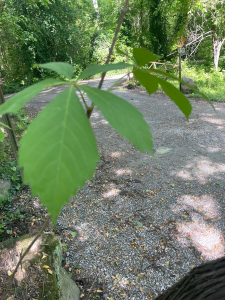To say I had a half-baked idea is generous. Metaphorically, I didn’t turn on the oven. I didn’t even open the recipe book.
Late last summer, I harvested a couple of pawpaws on a trail run. Usually, when I find a ripe pawpaw on the trail, I pick apart the fruit on the spot, to get a sweet little snack, and inevitably coat my hands and face generously with pawpaw goo. This time, I decided to pocket these fruits and take them home. While enjoying the fruit in the backyard, I decided to plant the seeds. While still sticky from the paw paw, I gathered up some potting soil, and compost, stirred them up, and stuck them in a pot. The seeds were put on the soil, then some old leaves were scattered on top. Everything got watered in well and put to the side in the backyard. I figured that this is more or less how pawpaws are planted in the woods, it ought to work here.
Since these fruit trees grow in the shade, they should be a good fruit tree for my backyard. I love the shade that my backyard trees provide, but that shade has made many of my gardening attempts fail. Pawpaw may be able to provide a little fruit where other garden plants fail.
After planting the seeds, I did a little research online. Pawpaw seedlings need shade, but after a year they can grow in full sun. Full sun will give more fruit, but they will grow some fruit in the shade. The trees along the James have shown that.
The online references also suggested scarifying the seeds, and stratification. Scarification is scratching the shell of the seed, but not the seed itself. This seems like a lot for my half-baked idea. I decided to leave the seeds in the pot as is. Stratification is subjecting the seeds to cold, so the seeds got to stay in a pot outside last winter; which was going to happen anyway.
I am not looking to grow a pawpaw orchard to give a bountiful harvest. I have more modest aspirations of watching a tree grow from seed, then someday being able to shake that tree in my backyard and get a couple of pieces of fruit. This will give me a little seasonal flavor. It is a sign that the days are getting shorter and fall is coming.
This spring, I checked the pot frequently. There was a bit of excitement watching a seedling come out of the soil, then disappointment when my misidentified seedling unfolded its sweet gum leaves. A few more spring weeds got my hopes up, by sprouting in the pot, then crushed my dreams by not being pawpaw. After some spring watering and weeding, I kind of gave up on the little pawpaw experiment sometime in May.

It seems like the pawpaw seedlings thrive on neglect; and summer rains. After a month or two of being forgotten, I checked the pot and several seedlings have sprouted. At first, I thought it was probably just another batch of weeds. A closer leaf inspection showed promise. Then I saw that one plant had not yet successfully shed the husk of the pawpaw seed, a sure sign that I have succeeded in my first step of growing pawpaw.

There are multiple seedlings, which is good. Pawpaw trees do not normally pollinate themselves.
This fall the seedlings will be bare-rooted and planted in the backyard. The online references recommend spring planting, but I probably will not wait. Why start following a recipe now?
These seedlings have a good chance of never bearing fruit. If they do, it won’t happen for another 5-8 years. If getting the fruit was important, I would be much better off buying some pawpaw trees. This is more of a slow journey. Watching seeds slowly grow into trees over the years will be more rewarding than the fruit that they may bear.




























































































































